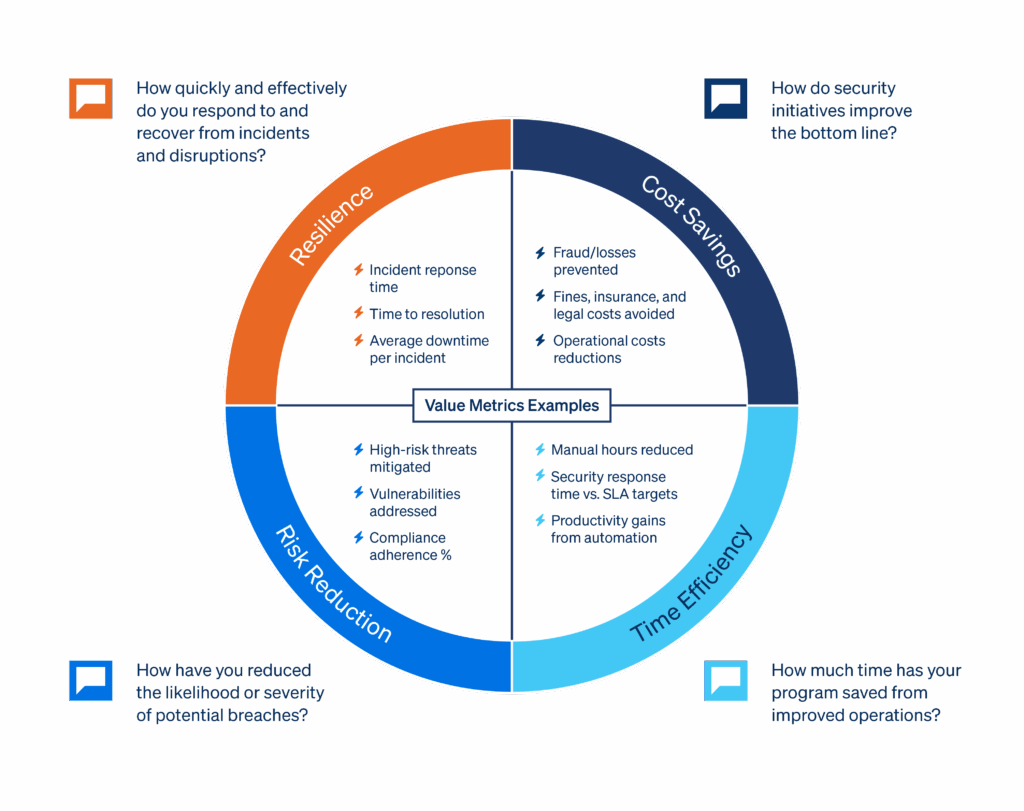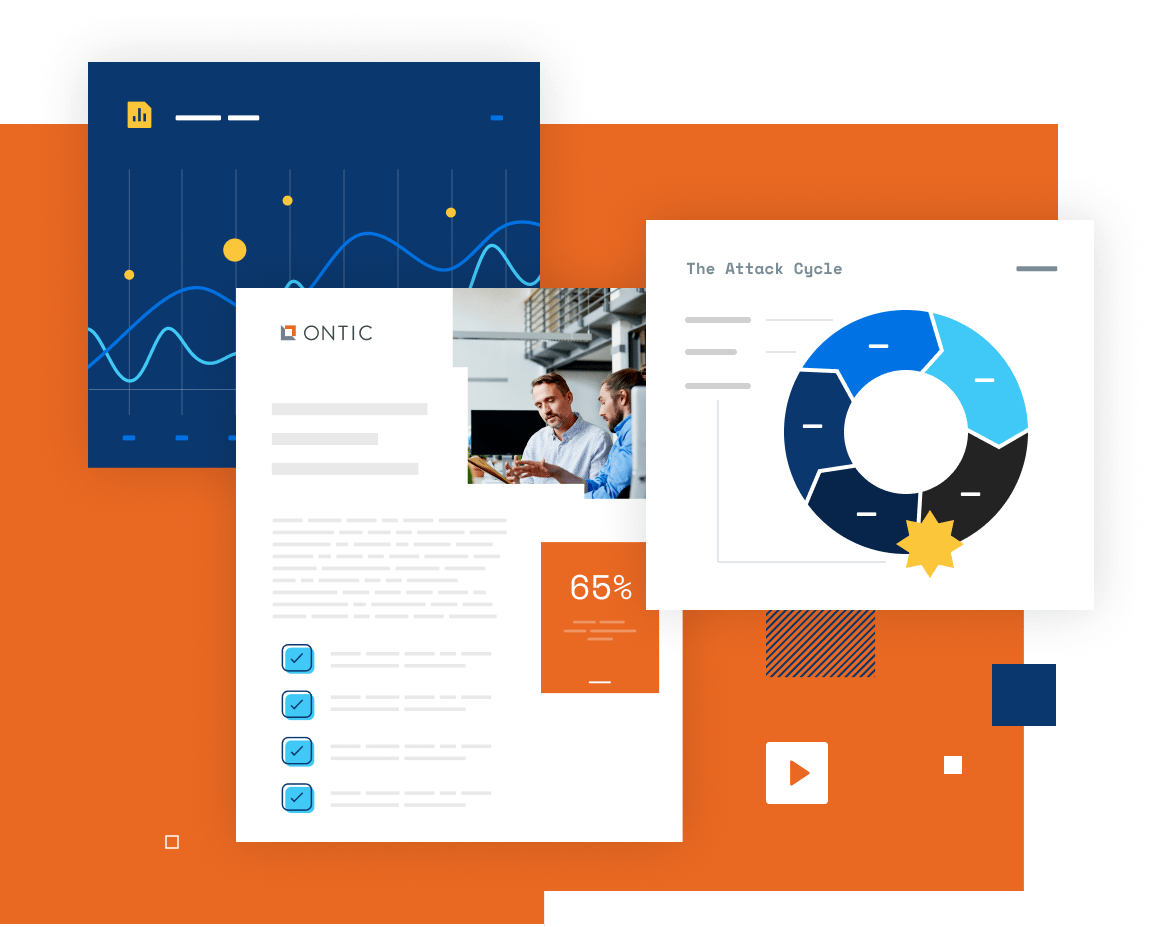Demonstrating Security ROI: The Four Business Metrics That Matter
Align the outcomes of your work with key business metrics to get the executive support you need for a stronger security program

Like most corporate security leaders today, you likely face a tough challenge: growing pressure to stay ahead of evolving threats without the resources to match. Despite its critical role in business continuity and revenue growth, security remains underfunded and undervalued in most enterprise organizations today.
The deeper challenge behind this issue is that security’s contributions often go underreported — and therefore, unrecognized. Many executives see security as a cost center focused on managing operational risks rather than a value driver enabling informed strategic risk-taking. In a recent survey, nearly half of security professionals cited executives’ lack of understanding of security as their top challenge.
As you know, underinvesting in security can have catastrophic consequences. The key to gaining support is showing decision-makers how your team’s work directly impacts what they care about most — business outcomes. This requires translating everyday security metrics into clear, tangible business value. By doing so, you highlight the true importance of your function and speak to executives in a language they understand.
So, what should you measure and report? To align security with executive priorities, translate your activity metrics, such as incident volume or completed assessments, into value metrics that reflect business impact. By doing so, you not only demonstrate the true value of your function but also engage executives in a language they understand. Focus on resilience, risk reduction, cost savings, and time efficiency. Let’s break these down.
From activity metrics to value metrics
Before we get into the business metrics that matter most, it’s important to distinguish between the two types of metrics:
- Activity metrics are operational. They help security teams manage day-to-day performance, like the number of incidents reported, cameras installed, or assessments completed. These are essential for internal oversight, trend analysis, resource allocation, and continuous improvement.
- Value metrics (also referred to here as business metrics) speak the language of executives. They connect security activities to broader business outcomes, such as reducing risk, saving time, avoiding financial loss, or improving operational continuity.
When reporting to executives, your focus should shift toward value metrics. These demonstrate how your security function protects and enables the business.
The four key metrics that focus on business value
Executives care about outcomes that drive business success. To show the value of security, frame your reporting around four key business drivers: resilience, risk reduction, cost savings, and time efficiency. The metrics that resonate most will depend on what the business is prioritizing at the time. For example, during a cost-cutting initiative, your executive team will be most interested in cost savings and time efficiency metrics. Here’s how each metric works, with examples of how security teams can apply them.

01
Resilience
Resilience reflects how quickly and effectively your organization can respond to and recover from incidents or disruptions — whether it’s a data breach, a protest near a critical facility, or a supply chain interruption. It’s a key indicator of operational continuity, directly influencing your company’s ability to bounce back from disruptions and maintain continuity.
Resilience metrics for security teams include:
- Incident response time
- Time to resolution
- Average downtime per incident
Regardless of the resilience metrics you’re tracking, linking them to broader business resilience is crucial. For example, if your team reduced the average incident response time at a manufacturing facility by 25%, you can connect this improvement to the potential cost of lost productivity. Suppose your baseline downtime costs $8,000 per hour, and you save one hour of downtime per incident by responding faster. Over multiple incidents, that saving multiplies, directly reinforcing business continuity and operational resilience.
Most teams can start tracking resilience early by measuring when an incident is detected and mitigation begins. Even basic trends can show progress over time. Be sure to avoid the common pitfall of reporting incident volume without tying it to outcomes like reduced downtime or avoided disruption. As programs mature, these metrics can evolve to include broader indicators of continuity and business impact.
02
Risk reduction
Risk reduction centers on preventing or reducing the severity of negative events before they happen (or reducing their impact if they do occur). Risk reduction metrics highlight how effectively your team mitigates threats and reduces liability.
Risk reduction metrics for security teams include:
- High-risk threats prevented before escalation
- Vulnerabilities addressed before breaches
- Compliance audit success rate
Teams at a maturing stage often begin surfacing risk reduction metrics by building on incident tracking. Avoid relying solely on counts and instead add context demonstrating how mitigation actions averted threats or minimized exposure to fines, lawsuits, or reputational harm.
For example, if a proactive threat assessment helped prevent three workplace violence incidents last year, and the average settlement cost for a workplace violence case ranges from $500,000 to $3 million, the costs avoided could be between $1.5 and $9 million.
03
Cost savings
Cost savings show how security initiatives protect your organization and improve the bottom line by reducing current or potential expenses and enabling smarter resource allocation. Some organizations may prefer the term “cost avoidance” — highlighting potential losses or risks that were averted thanks to proactive security measures. The key is clearly showing how your work contributes to financial protection or efficiency.
Cost savings metrics for security teams include:
- Fraud losses avoided
- Regulatory fines prevented
- Insurance premium reductions
These metrics become more relevant in mature programs with historical data and benchmarks. Start by estimating what a single prevented incident might cost your organization, and scale from there. Avoid vague cost savings claims — whenever possible, use data from past losses or incident outcomes to ground your estimates.
Let’s say you’ve calculated that the average loss from fraud or theft incidents is $100K per incident based on real data from the past five years. If your new fraud/theft prevention strategy prevented 10 incidents last year alone, you saved the organization $1M in potential losses.
04
Time efficiency
Efficient security processes free up people and systems to focus on what matters. Time efficiency metrics show how security operations boost productivity.
Time efficiency metrics for security teams include:
- Hours saved via automation (like reporting or alert triage)
- Incidents handled per team member
- Reduction in average investigation time
Time efficiency is often the easiest entry point for teams at any stage. Look for repetitive tasksthat are ripe for automation or improved workflows. Avoid the trap of counting hours saved without showing what those hours enabled — tie time savings to strategic gains like quicker investigations or improved resource focus.
If an automated alert triage saved 200 staff hours per quarter, you could calculate the dollar value of those hours. For example, with an average hourly pay of $80, 200 hours equates to $16,000 per quarter. This time can then be reallocated to more impactful tasks, like conducting behavioral threat assessments that prevent major workplace violence incidents, leading to even greater cost savings.
Secure your seat at the table
Your work has always been important — keeping organizations safe and productive drives business outcomes. However, to secure the funding and buy-in needed to operate at a high level, you must convince decision-makers who have historically viewed security as a cost center.
The key is aligning your metrics with the language of business — resilience, risk reduction, cost savings, and time efficiency. By speaking this language, you demonstrate that without your critical function, the organization wouldn’t run as efficiently or effectively as it does today.
Frame your work in terms of outcomes. Report consistently. And share real numbers. Remember, credibility grows when you speak the language of business, not just the language of security.









